Thomas Merritt
Investigating self-supervised features for expressive, multilingual voice conversion
May 13, 2025



Abstract:Voice conversion (VC) systems are widely used for several applications, from speaker anonymisation to personalised speech synthesis. Supervised approaches learn a mapping between different speakers using parallel data, which is expensive to produce. Unsupervised approaches are typically trained to reconstruct the input signal, which is composed of the content and the speaker information. Disentangling these components is a challenge and often leads to speaker leakage or prosodic information removal. In this paper, we explore voice conversion by leveraging the potential of self-supervised learning (SSL). A combination of the latent representations of SSL models, concatenated with speaker embeddings, is fed to a vocoder which is trained to reconstruct the input. Zero-shot voice conversion results show that this approach allows to keep the prosody and content of the source speaker while matching the speaker similarity of a VC system based on phonetic posteriorgrams (PPGs).
* Published as a conference paper at ICASSP 2024
AE-Flow: AutoEncoder Normalizing Flow
Dec 27, 2023Abstract:Recently normalizing flows have been gaining traction in text-to-speech (TTS) and voice conversion (VC) due to their state-of-the-art (SOTA) performance. Normalizing flows are unsupervised generative models. In this paper, we introduce supervision to the training process of normalizing flows, without the need for parallel data. We call this training paradigm AutoEncoder Normalizing Flow (AE-Flow). It adds a reconstruction loss forcing the model to use information from the conditioning to reconstruct an audio sample. Our goal is to understand the impact of each component and find the right combination of the negative log-likelihood (NLL) and the reconstruction loss in training normalizing flows with coupling blocks. For that reason we will compare flow-based mapping model trained with: (i) NLL loss, (ii) NLL and reconstruction losses, as well as (iii) reconstruction loss only. Additionally, we compare our model with SOTA VC baseline. The models are evaluated in terms of naturalness, speaker similarity, intelligibility in many-to-many and many-to-any VC settings. The results show that the proposed training paradigm systematically improves speaker similarity and naturalness when compared to regular training methods of normalizing flows. Furthermore, we show that our method improves speaker similarity and intelligibility over the state-of-the-art.
Creating New Voices using Normalizing Flows
Dec 22, 2023



Abstract:Creating realistic and natural-sounding synthetic speech remains a big challenge for voice identities unseen during training. As there is growing interest in synthesizing voices of new speakers, here we investigate the ability of normalizing flows in text-to-speech (TTS) and voice conversion (VC) modes to extrapolate from speakers observed during training to create unseen speaker identities. Firstly, we create an approach for TTS and VC, and then we comprehensively evaluate our methods and baselines in terms of intelligibility, naturalness, speaker similarity, and ability to create new voices. We use both objective and subjective metrics to benchmark our techniques on 2 evaluation tasks: zero-shot and new voice speech synthesis. The goal of the former task is to measure the precision of the conversion to an unseen voice. The goal of the latter is to measure the ability to create new voices. Extensive evaluations demonstrate that the proposed approach systematically allows to obtain state-of-the-art performance in zero-shot speech synthesis and creates various new voices, unobserved in the training set. We consider this work to be the first attempt to synthesize new voices based on mel-spectrograms and normalizing flows, along with a comprehensive analysis and comparison of the TTS and VC modes.
* Interspeech 2022
Comparing normalizing flows and diffusion models for prosody and acoustic modelling in text-to-speech
Jul 31, 2023Abstract:Neural text-to-speech systems are often optimized on L1/L2 losses, which make strong assumptions about the distributions of the target data space. Aiming to improve those assumptions, Normalizing Flows and Diffusion Probabilistic Models were recently proposed as alternatives. In this paper, we compare traditional L1/L2-based approaches to diffusion and flow-based approaches for the tasks of prosody and mel-spectrogram prediction for text-to-speech synthesis. We use a prosody model to generate log-f0 and duration features, which are used to condition an acoustic model that generates mel-spectrograms. Experimental results demonstrate that the flow-based model achieves the best performance for spectrogram prediction, improving over equivalent diffusion and L1 models. Meanwhile, both diffusion and flow-based prosody predictors result in significant improvements over a typical L2-trained prosody models.
Remap, warp and attend: Non-parallel many-to-many accent conversion with Normalizing Flows
Nov 10, 2022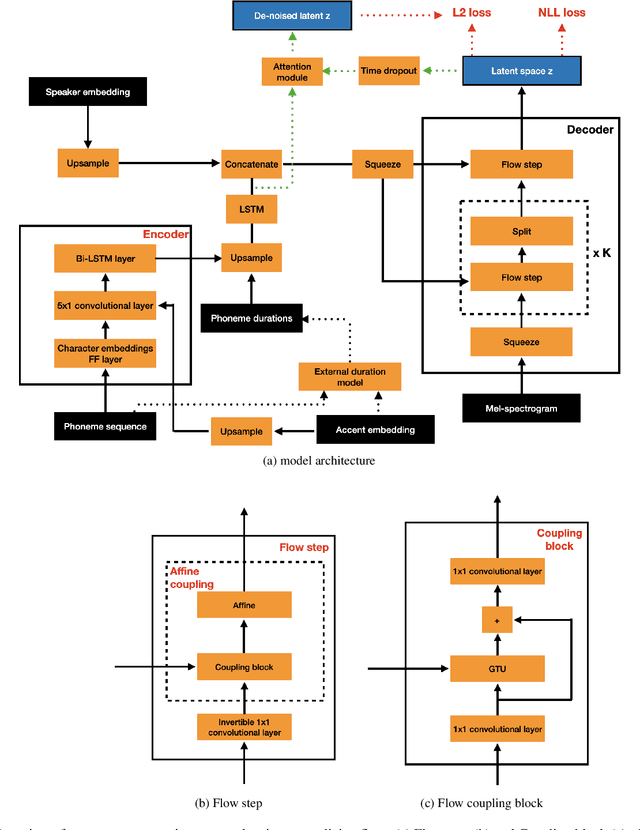

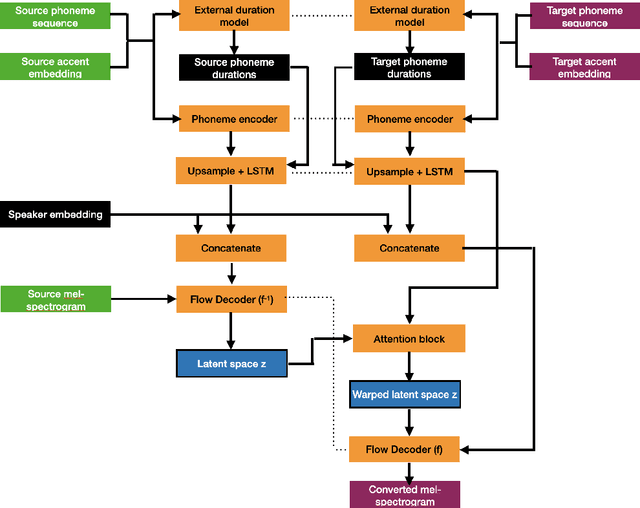

Abstract:Regional accents of the same language affect not only how words are pronounced (i.e., phonetic content), but also impact prosodic aspects of speech such as speaking rate and intonation. This paper investigates a novel flow-based approach to accent conversion using normalizing flows. The proposed approach revolves around three steps: remapping the phonetic conditioning, to better match the target accent, warping the duration of the converted speech, to better suit the target phonemes, and an attention mechanism that implicitly aligns source and target speech sequences. The proposed remap-warp-attend system enables adaptation of both phonetic and prosodic aspects of speech while allowing for source and converted speech signals to be of different lengths. Objective and subjective evaluations show that the proposed approach significantly outperforms a competitive CopyCat baseline model in terms of similarity to the target accent, naturalness and intelligibility.
GlowVC: Mel-spectrogram space disentangling model for language-independent text-free voice conversion
Jul 04, 2022


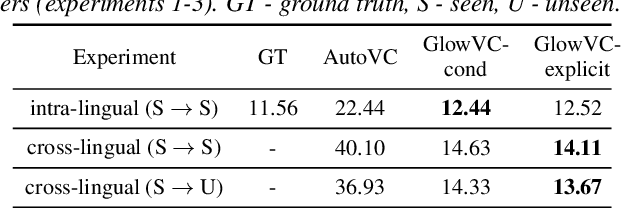
Abstract:In this paper, we propose GlowVC: a multilingual multi-speaker flow-based model for language-independent text-free voice conversion. We build on Glow-TTS, which provides an architecture that enables use of linguistic features during training without the necessity of using them for VC inference. We consider two versions of our model: GlowVC-conditional and GlowVC-explicit. GlowVC-conditional models the distribution of mel-spectrograms with speaker-conditioned flow and disentangles the mel-spectrogram space into content- and pitch-relevant dimensions, while GlowVC-explicit models the explicit distribution with unconditioned flow and disentangles said space into content-, pitch- and speaker-relevant dimensions. We evaluate our models in terms of intelligibility, speaker similarity and naturalness for intra- and cross-lingual conversion in seen and unseen languages. GlowVC models greatly outperform AutoVC baseline in terms of intelligibility, while achieving just as high speaker similarity in intra-lingual VC, and slightly worse in the cross-lingual setting. Moreover, we demonstrate that GlowVC-explicit surpasses both GlowVC-conditional and AutoVC in terms of naturalness.
Expressive, Variable, and Controllable Duration Modelling in TTS
Jun 28, 2022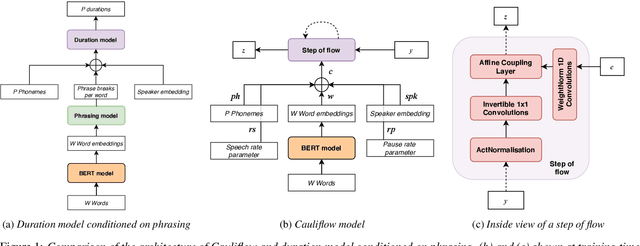


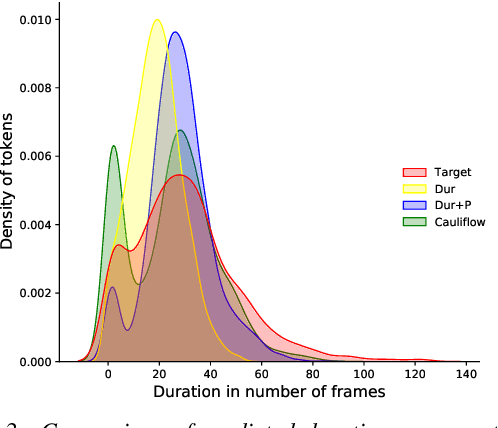
Abstract:Duration modelling has become an important research problem once more with the rise of non-attention neural text-to-speech systems. The current approaches largely fall back to relying on previous statistical parametric speech synthesis technology for duration prediction, which poorly models the expressiveness and variability in speech. In this paper, we propose two alternate approaches to improve duration modelling. First, we propose a duration model conditioned on phrasing that improves the predicted durations and provides better modelling of pauses. We show that the duration model conditioned on phrasing improves the naturalness of speech over our baseline duration model. Second, we also propose a multi-speaker duration model called Cauliflow, that uses normalising flows to predict durations that better match the complex target duration distribution. Cauliflow performs on par with our other proposed duration model in terms of naturalness, whilst providing variable durations for the same prompt and variable levels of expressiveness. Lastly, we propose to condition Cauliflow on parameters that provide an intuitive control of the pacing and pausing in the synthesised speech in a novel way.
Text-free non-parallel many-to-many voice conversion using normalising flows
Mar 15, 2022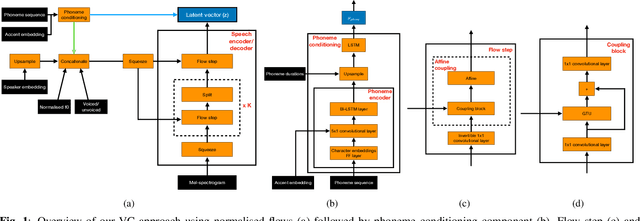
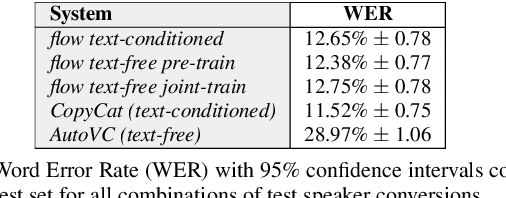
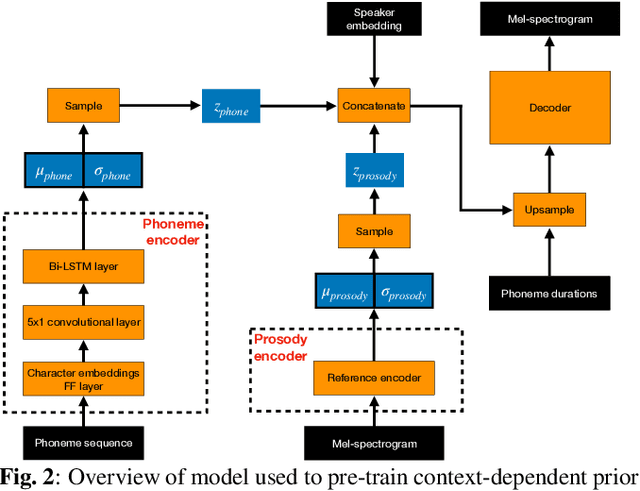

Abstract:Non-parallel voice conversion (VC) is typically achieved using lossy representations of the source speech. However, ensuring only speaker identity information is dropped whilst all other information from the source speech is retained is a large challenge. This is particularly challenging in the scenario where at inference-time we have no knowledge of the text being read, i.e., text-free VC. To mitigate this, we investigate information-preserving VC approaches. Normalising flows have gained attention for text-to-speech synthesis, however have been under-explored for VC. Flows utilize invertible functions to learn the likelihood of the data, thus provide a lossless encoding of speech. We investigate normalising flows for VC in both text-conditioned and text-free scenarios. Furthermore, for text-free VC we compare pre-trained and jointly-learnt priors. Flow-based VC evaluations show no degradation between text-free and text-conditioned VC, resulting in improvements over the state-of-the-art. Also, joint-training of the prior is found to negatively impact text-free VC quality.
Non-Autoregressive TTS with Explicit Duration Modelling for Low-Resource Highly Expressive Speech
Jun 25, 2021



Abstract:Whilst recent neural text-to-speech (TTS) approaches produce high-quality speech, they typically require a large amount of recordings from the target speaker. In previous work, a 3-step method was proposed to generate high-quality TTS while greatly reducing the amount of data required for training. However, we have observed a ceiling effect in the level of naturalness achievable for highly expressive voices when using this approach. In this paper, we present a method for building highly expressive TTS voices with as little as 15 minutes of speech data from the target speaker. Compared to the current state-of-the-art approach, our proposed improvements close the gap to recordings by 23.3% for naturalness of speech and by 16.3% for speaker similarity. Further, we match the naturalness and speaker similarity of a Tacotron2-based full-data (~10 hours) model using only 15 minutes of target speaker data, whereas with 30 minutes or more, we significantly outperform it. The following improvements are proposed: 1) changing from an autoregressive, attention-based TTS model to a non-autoregressive model replacing attention with an external duration model and 2) an additional Conditional Generative Adversarial Network (cGAN) based fine-tuning step.
In Other News: A Bi-style Text-to-speech Model for Synthesizing Newscaster Voice with Limited Data
Apr 04, 2019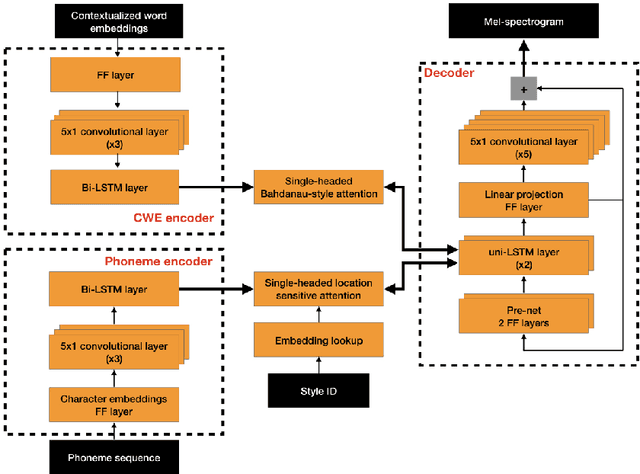



Abstract:Neural text-to-speech synthesis (NTTS) models have shown significant progress in generating high-quality speech, however they require a large quantity of training data. This makes creating models for multiple styles expensive and time-consuming. In this paper different styles of speech are analysed based on prosodic variations, from this a model is proposed to synthesise speech in the style of a newscaster, with just a few hours of supplementary data. We pose the problem of synthesising in a target style using limited data as that of creating a bi-style model that can synthesise both neutral-style and newscaster-style speech via a one-hot vector which factorises the two styles. We also propose conditioning the model on contextual word embeddings, and extensively evaluate it against neutral NTTS, and neutral concatenative-based synthesis. This model closes the gap in perceived style-appropriateness between natural recordings for newscaster-style of speech, and neutral speech synthesis by approximately two-thirds.
 Add to Chrome
Add to Chrome Add to Firefox
Add to Firefox Add to Edge
Add to Edge